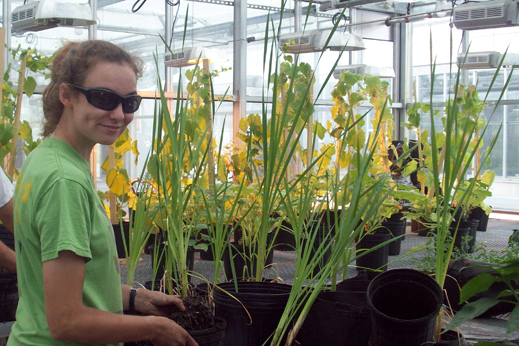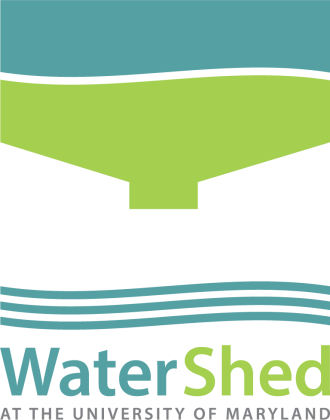
Team Leader Isabel Enerson Tending to Plants in the Greenhouse
Photo Credit: Scott Tjaden
When visitors file through WaterShed at the Solar Decathlon this fall, they probably won’t know the informative and well-orchestrated tour highlighting the many features of the house was a months-long odyssey for Isabel Enerson. Or that the beautiful plantings were lovingly raised from infancy for months under Isabel’s care. Both are examples of the behind-the-scenes detail that defines WaterShed, and the work of students like Isabel.
An Environmental Science and Technology major with a passion for both education and ecological design, Isabel has been wearing two very important hats on this project: educational guide coordinator and living systems team member. The educational component stretches to include outreach to high schools and campus groups, but the lion’s share of the work is the preparation of materials, tour guide training, and scheduling of what will be a jam-packed 10 days on the National Mall. Isabel does leave time to get her hands dirty; using her knowledge in environmental science, she was involved in the wetland design and championed nutrient cycling for the living systems team. Below she talks about the value of both her teammates and good soil.
What has been your personal WaterShed moment so far?
IE: I think one of the most rewarding experiences has been the process – which may seem like a total cop out, but it’s the first thing I think of. There is something amazing about having an idea turn into a design and then a reality. For me the most physical reality was the greenhouses; we started with tiny plugs and seeds in the early spring and now have hundreds of full-grown plants.
Talk about an unexpected, amazing, frightening, or unlikely experience while working on WaterShed…
IE: I don’t think there are many other projects where you’d find mud-covered co-workers jamming out to techno while repotting plants at 1 am.
What’s an aspect of the project you value most?
IE: I value the interdisciplinary aspect of this project the most. It is truly invaluable to be able to understand how to work with engineers and architects, some of whom seem to speak a language unto themselves before you crack the code. Fenestration?! “Efficiency, no problem – our LDW, ERV, and Mini Splits will keep you comfy with minimal energy use!” Wait, my WHAT? A year later I find myself tossing these terms into conversations with my friends and family only to meet some seriously quirked eyebrows. However, it’s bigger than that because working with peers, professors, and professionals outside of your expertise allows you to understand how different components interrelate – plus you meet some pretty interesting, passionate, and intelligent folks!
Has working on WaterShed influenced your career path?
IE: It has reinforced my desire to enable communities to become sustainable. I’m still working on the how, but I’m considering more design-related fields after my involvement in this project. I also really love the educational aspect of communication – which is no new revelation – but this project has been an interesting exercise in educating about something YOU have designed and built where suddenly every detail is important and it seems impossible to leave out.
When people come to visit WaterShed on the Mall in September, what do you hope they will take away from the experience?
IE: EVERYTHING! Okay, that was a little over exuberant, but I really hope our house provides an ah ha moment for our visitors. “Ah ha”… we ARE part of the environment. “Ah ha”… it is possible to be sustainable and have a gorgeous house. “Ah ha”… plants can do a lot more than look pretty. “Ah ha”… small can be spacious. “Ah ha”… alternate energy can be ample. “Ah ha”… I can try x in my home or lifestyle! If WaterShed can serve as the catalyst for just one person to have any of these realization and act on it I’d be quite happy.
What do you always have with you on the job site?
IE: Hmm, I’m just going to switch out “job site” with “greenhouse” and say a box cutter, those things are insanely useful!
